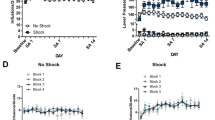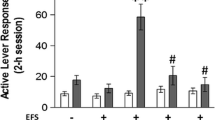Abstract
Rationale and objective.
It is well established that stress induces reinstatement of drug seeking in an animal model of relapse. Here we studied the role of the medial prefrontal cortex (mPFC) and orbitofrontal cortex (OFC) in foot-shock stress-induced reinstatement of cocaine seeking.
Methods.
Groups of rats were trained to self-administer cocaine (0.5 mg/kg per infusion, i.v., 3 h/day for 9 days) and after ten drug-free days were exposed to extinction and reinstatement test sessions. Each 60 min of extinction was separated by a 30-min time-out period after which the lever and stimulus lights were reintroduced. Rats were given four 1-h extinction sessions on day 1 and then on subsequent days were given two to three 1-h extinction sessions that were followed by a 3-h test for reinstatement. Tests were run every 48 h. In one set of experiments, the effects of inactivation of the prelimbic (PL), infralimbic (IL) or OFC by tetrodotoxin (TTX, 5 ng/0.5 µl per side) on reinstatement induced by foot shock (5 min, intermittent, 1 mA) or priming injections of cocaine (20 mg/kg, i.p.) were determined. In a second set, the effects of infusions of the D1-like and D2-like dopamine receptor antagonists (SCH 23390 and raclopride) were studied using the same methods.
Results.
TTX infusions into the PL cortex blocked both foot shock and cocaine-induced reinstatement. TTX into OFC attenuated foot-shock-induced, but not cocaine-induced reinstatement. Infusions into IL were ineffective. Infusions of SCH 22390 (0.25 µg/0.5 µl per side) into either PL or OFC blocked foot-shock-induced reinstatement, but infusions into PL had no effect on cocaine-induced reinstatement. Raclopride (5 µg/0.5 µl per side) had no effect on foot-shock-induced reinstatement in either PL or OFC or on cocaine-induced reinstatement when infused into PL. Neither TTX nor SCH23390 infusions into PL or OFC had any effect on lever pressing for sucrose.
Conclusions.
These results suggest that the PL and OFC regions form part of the circuitry mediating the effects of foot shock stress on reinstatement of drug seeking and that the PL region may be a common pathway for cue, drug and foot-shock stress-induced reinstatement of drug seeking.





Similar content being viewed by others
References
Bechara A, Damasio H, Damasio AR (2000) Emotion, decision making and the orbitofrontal cortex. Cereb Cortex 10:295–307
Castner SA, Williams GV, Goldman-Rakic PS (2000) Reversal of antipsychotic-induced working memory deficits by short-term dopamine D1 receptor stimulation. Science 287:2020–2022
Emmi A, Rajabi H, Stewart J (1997) Behavioral and neurochemical recovery from partial 6-hydroxydopamine lesions of the substantia nigra is blocked by daily treatment with D1/D5, but not D2, dopamine receptor antagonists. J Neurosci 17:3840–3846
Erb S, Salmaso N, Rodaros D, Stewart J (2001) A role for the CRF-containing pathway from central nucleus of the amygdala to the bed nucleus of the stria terminalis in stress-induced relapse to cocaine seeking in rats. Psychopharmacology 158:360–365
Franklin TR, Acton P, Maldjian JA, Gray JD, Croft JR, Dackis CA, O'Brien CP, Childress AR (2002) Deacreased gray matter concentration in the insular, orbitofrontal, cingulate, and temporal cortices of cocaine patients. Biol Psychiatry 51:134–142
Goeders NE, Smith JE (1983) Cortical dopaminergic involvement in cocaine reinforcement. Science 221:773–775
Goeders NE, Smith JE (1986) Reinforcing properties of cocaine in the medial prefrontal cortex: primary action on presynaptic dopaminergic terminals. Pharmacol Biochem Behav 25:191–199
Graham JH, Porrino LJ (1995) Neuroanatomical substrates of cocaine self-administration. In: Hammer RP Jr (ed) Neurobiology of cocaine. CRC Press, Boca Raton, pp 3–14
Highfield D, Clements A, Shalev U, McDonald R, Featherstone R, Stewart J, Shaham Y (2000) Involvement of the medial septum in stress-induced relapse to heroin seeking in rats. Eur J Neurosci 12:1705–1713
Hollerman JR, Tremblay L, Schultz W (2000) Involvement of basal ganglia and orbitofrontal cortex in goal-directed behavior. Prog Brain Res 126:193–215
Jentsch JD, Taylor JR (1999) Impulsivity resulting from frontostriatal dysfunction in drug abuse: implications for the control of behavior by reward-related stimuli. Psychopharmacology 146:373–390
Johansen JP, Fields HL, Manning BH (2001) The affective component of pain in rodents: direct evidence for a contribution of the anterior cingulate cortex. Proc Natl Acad Sci USA 98:8077–8082
Leri F, Bruneau J, Stewart J (2002) Understanding poly-drug use: heroin and cocaine. Addiction (in press)
Lyons D, Friedman DP, Nader MA, Porrino LJ (1996) Cocaine alters cerebral metabolism within the ventral striatum and limbic cortex of monkeys. J Neurosci 16:1230–1238
McFarland K, Kalivas PW (2001) The circuitry mediating cocaine-induced reinstatement of drug-seeking behavior. J Neurosci 21:8655–8663
O'Doherty J, Kringelbach ML, Rolls ET, Hornak J, Andrews C (2001) Abstract reward and punishment representations in the human orbitofrontal cortex. Nat Neurosci 4:95–102
Park WK, Bari AA, Jey AR, Anderson SM, Spealman RD, Rowlett JK, Pierce RC (2002) Cocaine administered into the medial prefrontal cortex reinstates cocaine-seeking behavior by increasing AMPA receptor-mediated glutamate transmission in the nucleus accumbens. J Neurosci 22:2916–2925
Paxinos G, Watson C (1997) The rat brain in stereotaxic coordinates, 3rd edn. Academic Press, New York
Rogers RD, Everitt BJ, Baldacchino A, Blackshaw AJ, Swainson R, Wynne K, Baker NB, Hunter J, Carthy T, Booker E, London M, Deakin JF, Sahakian BJ, Robbins TW (1999) Dissociable deficits in the decision-making cognition of chronic amphetamine abusers, opiate abusers, patients with focal damage to prefrontal cortex, and tryptophan-depleted normal volunteers: evidence for monoaminergic mechanisms. Neuropsychopharmacology 20:322–339
See RE (2002) Neural substrates of conditioned-cued relapse to drug-seeking behavior. Pharmacol Biochem Behav 71:517–529
See RE, Kruzich PJ, Grimm JW (2001) Dopamine, but not glutamate, receptor blockade in the basolateral amygdala attenuates conditioned reward in a rat model of relapse to cocaine-seeking behavior. Psychopharmacology 154:301–310
Shaham Y, Stewart J (1995) Stress reinstates heroin-seeking in drug-free animals: an effect mimicking heroin, not withdrawal. Psychopharmacology 119:334–341
Shaham Y, Erb S, Stewart J (2000) Stress-induced relapse to heroin and cocaine seeking in rats: a review. Brain Res Rev 33:13–33
Shaham Y, Shalev U, Lu L, de Wit H, Stewart J (2002) The reinstatement model of drug relapse: history, methodology and major findings. Psychopharmacology DOI 10.1007/s00213-002-1224-x
Shalev U, Grimm JW, Shaham Y (2002) Neurobiology of relapse to heroin and cocaine seeking: a review. Pharmacol Rev 54:1–42
Small DM, Zatorre RJ, Dagher A, Evans AC, Jones-Gotman M (2001) Changes in brain activity related to eating chocolate: from pleasure to aversion. Brain 124:1720–1733
Stewart J (2000) Pathways to relapse: the neurobiology of drug- and stress-induced relapse to drug-taking. J Psychiatr Neurosci 25:125–136
Stewart J (2003) Pathways to relapse: factors controlling the reinitiation of drug seeking after abstinence. In: Bardo MT (ed) The Nebraska symposium on motivation: motivational factors in the etiology of drug abuse. University of Nebraska Press, Lincoln (in press)
Vezina P, Blanc G, Glowinski J, Tassin J-P (1994) Blockade of D-1 dopamine receptors in the medial prefrontal cortex produces delayed effects on pre- and postsynaptic indices of dopamine function in the nucleus accumbens. Synapse 16:104–112
Volkow ND, Fowler JS (2000) Addiction, a disease of compulsion and drive: involvement of the orbitofrontal cortex. Cereb Cortex 10:318–325
Volkow ND, Fowler JS, Wolf AP, Hitzemann R, Dewey S, Bendriem B, Alpert R, Hoff A (1991) Changes in brain glucose metabolism in cocaine dependence and withdrawal. Am J Psychiatry 148:621–626
Volkow ND, Hitzemann R, Wang GJ, Fowler JS, Wolf AP, Dewey SL, Handlesman L (1992) Long-term frontal brain metabolic changes in cocaine abusers. Synapse 11:184–190
Zilles K (1985) The cortex of the rat: a stereotaxic atlas. Springer, Berlin Heidelberg New York
Acknowledgements.
We thank Francesco Leri for his help with the study on sucrose reinforcement. Supported by grants from the National Institute of Drug Abuse (USA) and Fonds pour la Formation de Chercheurs et l'Aide à la Recherche du Québec (FCAR).
Author information
Authors and Affiliations
Corresponding author
Rights and permissions
About this article
Cite this article
Capriles, N., Rodaros, D., Sorge, R.E. et al. A role for the prefrontal cortex in stress- and cocaine-induced reinstatement of cocaine seeking in rats. Psychopharmacology 168, 66–74 (2003). https://doi.org/10.1007/s00213-002-1283-z
Received:
Accepted:
Published:
Issue Date:
DOI: https://doi.org/10.1007/s00213-002-1283-z




